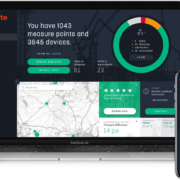Recent years have seen significant advancements in construction industry sensor solutions. As a result, contractors can today monitor construction site data over cloud-connected wireless sensors. This ensures timely project completion and saves engineering resources wasted in collecting the same data over multiple trips to the job site.
One critical job site measurement, as discussed in this article, is for concrete floor moisture. By using real-time data and alerts on concrete slab conditions, contractors will be able to install the flooring at the right time – when it is dry enough but not too late for the project schedule.
Using big-data analytics with millions of data points in the database, it is even possible to predict the calendar day when the slab is ready for flooring!
The Problem is Still There – Concrete Slabs Hold Water
The commonality of damage to flooring due to high moisture content persists—claims related to concrete slab moisture issues in the USA cost upwards of $1 billion yearly. New types of concrete mixes, new types of floor coverings, and even the new LEED guidelines are making matters worse by creating conditions more sensitive to excess moisture. It certainly looks like the flooring industry will continue struggling with flooring moisture issues also in the future.
To solve this problem at the job site, contractors currently have two options: they can accept the cost of waiting for the concrete slab to dry (typically $10-20k per day) or, they can accept the cost of an additional moisture barrier coating to allow installation on a high humidity surface. Either way, it is essential to adequately measure moisture levels in the concrete before selecting the appropriate approach.
Concrete Moisture Measurement Methods
ASTM defines two widely used measurement methods. One is the Moisture Vapor Emission Rate (MVER) by the calcium chloride method described in ASTM F1869. This test measures moisture emitted from the top 0.5-0.8” layer of the slab only. The other method, ASTM F2170 in-situ probe, is based on inserting probes in holes drilled into the slab. This measures moisture inside the concrete as % relative humidity. It is a good predictor of future moisture emission and helps determine the moisture level in the slab once the flooring materials are installed.
While there is no direct relationship between MVER and F2170 measurements, both pieces of information can be helpful. However, because the MVER measurement alone is considered insufficient, the F2170 RH method has captured the de-facto-standard role for moisture measurement in all professional flooring installations, either alone or with MVER measurement.
Different Types of ASTM F2170 Sensors
The ASTM2170 measurement kit includes a sensor that is, in a plastic sleeve, inserted into a hole drilled into concrete. The meter is connected to sensor cable, and RH value is read 24 hours after drilling of the hole.
Some of the sensors in the market today use wireless Bluetooth radio chips so that sensors can be read with a smartphone by simply walking through the job site. This makes the inspection job easier because it removes the cable between the sensor and the meter, but it still requires an onsite presence for the measurement, which can be a challenge to many concrete floor inspectors. To continue monitoring the drying concrete, the inspector must drive back to the job site multiple times, often to realize that the slab is still not dry enough and come back later. This repeat-trip process will accumulate costs. It may also result in losing valuable time in a fast-track contract if the floor was already dry and ready, but nobody was on site to measure it.
The latest evolution of concrete sensors is the wireless, cloud-connected IoT sensor using the ASTM 2170 method. This is made possible by using wide-area network radio technology, such as LoraWAN carrier networks for IoT data. Each LoraWAN sensor can be directly and individually connected to the internet and the cloud dashboard, with no wireless gateways or base stations, required onsite. This makes sensor installation easy and enables the flooring contractor to receive mobile notifications exactly at the moment when the concrete slab is ready for installation. Time and money saved!
eGate Nsens – a cloud-connected ASTM F2170 probe for remote data, alerts, and predictive analysis
eGate Nsens is using LoraWAN wireless coverage to connect to the cloud. Once installed to a drilled hole, the sensor is already automatically connected to the eGate cloud dashboard with mobile data.
Over several years of its operations in the construction industry, eGate has collected over 150 million concrete measurement data points on its cloud database. Based on this historical data set, it is possible to predict the concrete slab drying curve. Even with just one eGate NSens probe installed onsite, after the first few hours of measurement, it will be possible to estimate the number of days to reach the target moisture level. eGate will be releasing its first commercial concrete moisture prediction tool during the 1Q21.
Concrete will Emit or Absorb Moisture Based on its Ambient Air Conditions
Drying concrete is different during cold and dry winter days than in high humidity during the summer. Therefore, it is also essential to monitor the ambient air conditions when predicting the concrete drying curve. With that in mind, the eGate team has developed a separate ambient air Temp & RH sensor, eGate Kube, that is connected to the same cloud platform for analysis and is an integral part of the prediction calculation.
Are you ready to work smarter during your next flooring project? For more information about eGate cloud-connected job site solutions, get in touch today.





Leave a Reply
Want to join the discussion?Feel free to contribute!